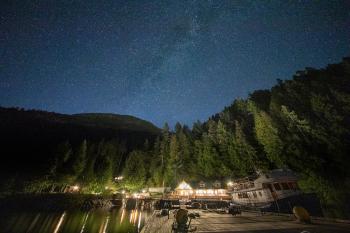Image Caption
Summary
Local Journalism Initiative Reporter
Windspeaker.com
In the midst of a pandemic, climate emergency and uncertain economic future, Klahoose First Nation is looking at ways to shift from fossil dependence to alternative sources of green energy.
Located in the Salish Sea, Klahoose territory is filled with the beauty—and the power of water.
At the Klahoose Wilderness Resort that power translates to 38 tonnes of carbon dioxide. That's the amount Klahoose will be reducing from its carbon footprint with a new hydro-electric system. The project is leveraging the power of a rugged, unnamed creek that cascades down from the glaciers that surround the peaks above the resort. Mount Denman rises up right behind the resort; straight up from sea level to 1920 metres.
“I’m happy to see our corporation and Nation turning to green energy. We take pride in what we do,” said Chief Kevin Peacey.
Klahoose First Nation is on the rise, and green energy at Klahoose Wilderness Resort is the latest initiative. Qathen Xwegus Management Corporation (QXMC) manager Bruno Perreira says Klahoose is moving strongly forward with a number of initiatives spurring economic development and employment. The First Nation is making use of green energy as an opportunity that brings environmental and economic benefits.
The resort has a power generating license, so they can use the water coming down the creek.
“It supplies what’s called the peloton wheel, but it's basically a hydro wheel. So the wheel turns and generates electricity and feeds the entire property,” said Perreira. To give scale, he says the present wheel has a capacity of four kilowatts. Because the intake is “kind of old and made with plywood, we are only able to produce one kilowatt. And with this new system, we will have, at all times, 12 kilowatts,” tripling their energy generation.
The nation was awarded a grant from the First Nation Clean Energy Business Fund to redesign and improve water intake, the peloton wheel and storage capacity at the resort.
This will bring state of the art equipment and improvements to their integrated remote, off-grid power system. They worked with Hakai Energy Solutions to help reduce dependency on diesel generators. The Nation shared news of a sea can with battery bank, inverters, and a monitoring system.
The improved system opens up many possibilities to be more reliable and safe in a remote area, said Perreira. The wilderness resort team is excited at the potential to add commodities and comfort.
“It allows us to really be 60 to 75 per cent completely sustainable with green energy,” says Perreira.
“The most important part was really to have battery capacity, energy stocking capacity, which we didn't have. And it's kind of a waste. You're like, ‘wow, it's so sad.’ There's so much energy. Sometimes we need to keep lights on to not burn the system and the coils.”
The new battery bank will store power and will eliminate roughly 70 liters of diesel a day, “or about 15,000 liters a year. This converts to 38.1 tonnes of CO2,” said Perreira.
Klahoose Wilderness Resort tourism manager Chris Tait describes the existing energy generation.
“The creek has always provided enough power to run the peloton wheel for most of the year.” However, the creek has limited water in August when it’s the driest. That is when the new batteries will be most helpful, storing the power generated.
Tait says this will allow them to continue using this clean energy. Until now, they have always needed a diesel generator for short periods of time to run the laundry or dishwashers when the lodge is full.
“The current system does not allow us to turn the generator off, and we still need to use diesel for short periods in the mornings and evenings. Turning the generator off in the evenings was always a bit of an event as the light flickers and we explained that we are off the generators and back on the peloton wheel. Fun when you are in the middle of the coastal rainforest many kilometres from the nearest road or community,” said Tait.
Tait says the improvement increases self-sufficiency.
“We can generate more power and. most importantly, store the power, which will make the entire operation more efficient.”
This will allow the resort to run at full capacity for longer periods of time during their season, and also extend the season. Perreira says the nation already has ideas in the works for community programs and possibly winter tourism at the resort.
Next steps include exploring electrifying their fleet of buses, installing chargers and solar panels at the band office, said Perreira.
Chief Peacey says he sees “a bright future ahead of ourselves going ‘eco’, and having more ideas on the rise.”
Local Journalism Initiative Reporters are supported by a financial contribution made by the Government of Canada.

